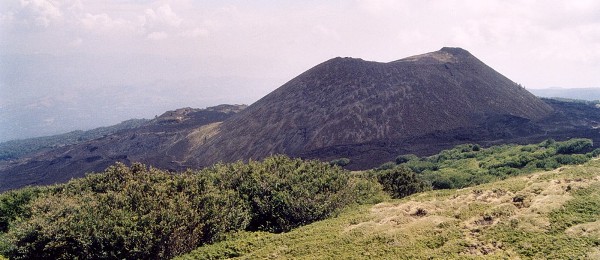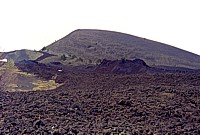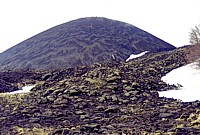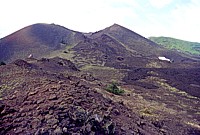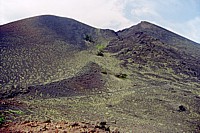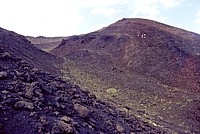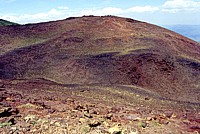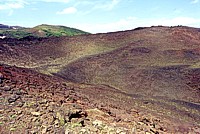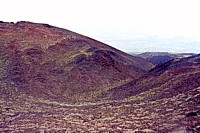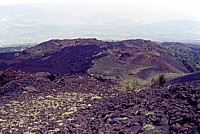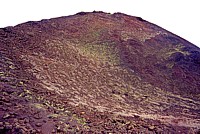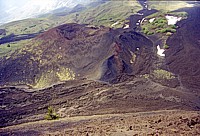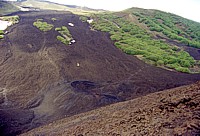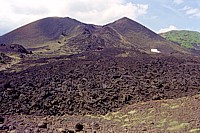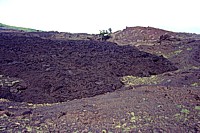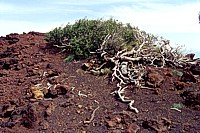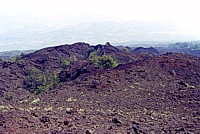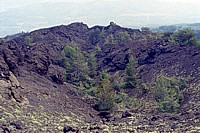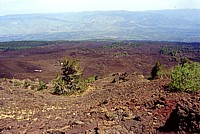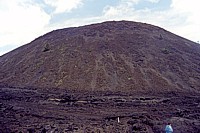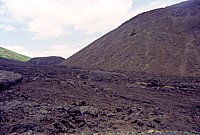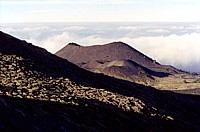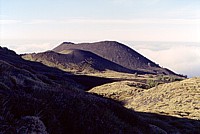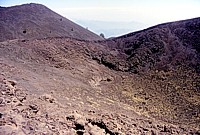| Etna
index |
||
| Geology | Geological history | Cones and craters |
| Eruptive characteristics | Eruptions before 1971 | Eruptions since 1971 |
| Etna and Man | References | Web sites |
| Weather forecasts | FAQ | Latest news |
Mamma
Etna's countless children
Monte Nero
NE flank, 15.028353° E, 37.807783° N (NW rim of crater)
Summit elevation: 2050 m
![]()
During
the first 70 years of the 17th century, between 1600 and 1669, Etna produced
a number of unusually large and devastating flank eruptions. One of the
smaller eruptions during that period - and yet a very large one if compared
to the eruptions of the past 300 years - occurred between November 1646
and January 1647 on the lower Northeast Rift where a much smaller eruption
had occurred three years earlier. Strong explosive activity built up a
row of large cones, the largest of which, at the lower end of the eruptive
fissure, rose about 150 m above the former surface and now forms one of
the most prominent landmarks on the northern-northeastern flank of Etna.
This cone was named Monte Nero, the Black Mountain (actually there are
three cones on Etna's flanks that bear this name). A large lava flow extended
toward the Alcantara valley and threatened several small settlements (the
longest lobe of the lava field attributed to the 1646 eruption, however,
is about 80 years older).
Monte Nero is a huge horseshoe-shaped cone open to the northeast, with
a base diameter of up to 0.5 km and its crater is nearly 200 m wide. On
the open side, the breach in the crater rim is filled by a conspicuous
ridge topped by an elongate depression, marking a series of effusive vents.
However, this ridge seems to be a feature formed relatively late during
the eruption. Morphological evidence indicates that Monte Nero first grew
as a symmetrical cone with a completely closed crater, before lava began
to pond within the crater and broke through the northern crater rim, pushing
two huge sections of the broken cone's flank for a distance of several
hundred meters. Then the lava broke through the front of the debris that
it had pushed ahead to form the large lava flow that extended toward the
Alcantara valley. The remains of the entrained debris derived from the
broken flank is now visible as a peculiar "collar" around a
broad lava-filled depression on the north base of Monte Nero, cut on its
northeast side by the lava flow that extended downslope.
Still more peculiarly, Monte Nero is one of the few examples on Etna where
a pre-existing flank crater has been the site of a more recent eruption.
During a major eruption in 1923, a system of eruptive fissures propagated
downrift in the direction of Monte Nero. When the dike cutting the surface
arrived at this cone, it was split up into three branches, two passing
on either side of Monte Nero, while a third one cut right across the cone
and arrived at the surface on its lower northeast flank in precise correspondence
with the late-formed effusive vents of the Monte Nero eruption. A small
volume of lava was erupted from this fissure segment, covering a portion
of the basin that lies within the debris "collar" formed by
the breaching of Monte Nero during its 1646-1647 eruption.
But Monte Nero is only the largest of a series of sizeable cones formed
during the same eruption. A little further uprift, one cone grew so large
that it was given a name on its own, Monte Ponte di Ferro. The uppermost
portion of the 1646-1647 eruptive fissure lies buried under younger lavas,
mostly those erupted in 1911 and 1923.
Until the 2002 eruption a little further to the east, the Monte Nero area
was a popular destination of hikers, and a trail leading from Piano Provenzana
to Monte Nero was completed in the spring of 2002, a few months before
the eruption. The hike was about 30 minutes and went across beautiful
forests before arriving in the Monte Nero area. Nearly all of the trail
was buried under the lavas erupted in late October-early November 2002
that also devastated Piano Provenzana, as were most other trails and dirt
roads leading to the Monte Nero area, so that all of a sudden this had
become one of the most isolated places on Etna. In the summer of 2003
a small footpath was made across the lowest part of the 2002 eruptive
fissure to render access to Monte Nero once more a bit easier, because
this area is really a volcanic showpiece. While the massive cone of Monte
Nero clearly dominates the scene, there are numerous smaller features
that are worth a close look. Foremost among these is the main eruptive
fissure of 1923 and its countless spatter cones and open pits. A climb
to the summit of Monte Nero is not an easy enterprise but is rewarded
by breathtaking panoramic views up and down the Northeast Rift and the
adjacent forested areas including the Alcantara valley and the Nebrodi
and Peloritani mountains to the north.
I first visited Monte Nero on a foggy day in early May 2000 and returned
a few weeks later when weather conditions had improved. Since then I have
visited the site several times a year, frequently with groups of hikers
and geology students. The photographs on this page were taken during many
of these visits and under quite variable meteorological conditions and
during different seasons of the year.
Copyright © Boris Behncke, "Italy's Volcanoes: The Cradle of Volcanology"
Page set up on 23 February 2004

